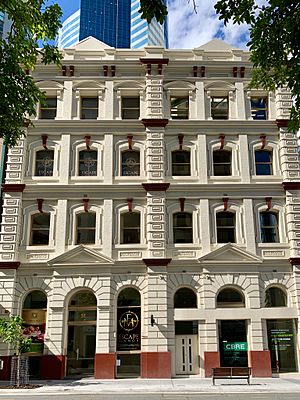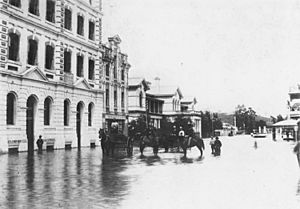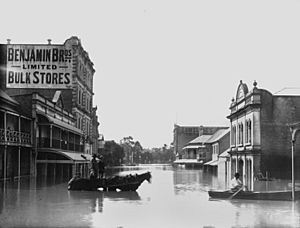Spencers Building facts for kids
Quick facts for kids Spencers Building |
|
|---|---|

Spencers Building, 2020
|
|
| Location | 45–47 and 49–51 Edward Street, Brisbane City, City of Brisbane, Queensland, Australia |
| Design period | 1870s – 1890s (late 19th century) |
| Built | 1889–1890 |
| Architect | Francis Drummond Greville Stanley |
| Architectural style(s) | Classicism |
| Official name: Spencers Building | |
| Type | state heritage (built) |
| Designated | 27 August 1993 |
| Reference no. | 600100 |
| Significant period | 1889–1890 (fabric)1903, 1911, 1913, 1941–1964 (historical) |
| Significant components | crane / gantry |
| Builders | Thomas Rees |
| Lua error in Module:Location_map at line 420: attempt to index field 'wikibase' (a nil value). | |
Spencers Building is a historic building in Brisbane City, Queensland, Australia. It's actually two buildings joined together, located on Edward Street. These buildings were once used as warehouses, which are big places for storing goods. A famous architect named Francis Drummond Greville Stanley designed them, and they were built between 1889 and 1890 by Thomas Rees. Because of its importance, Spencers Building was added to the Queensland Heritage Register on 27 August 1993, meaning it's protected for future generations.
Building History
The land where Spencers Building stands today was first bought by James Donald in 1852 and Benjamin Cribb in 1854. They worked together to divide and re-divide the land. By 1876, William Hood owned the land. His company, Hood & Binnie, had an iron factory there until 1888.
In 1888, Frances Sophia Jones, whose husband was a church leader, became the owner of the land. It was quite unusual for a married woman to own such property back then. Before 1890, husbands usually controlled any money made from their wife's property. Frances Jones borrowed a lot of money, probably to pay for the new building.
The building was finished by early 1890. Benjamin Brothers Ltd moved into one part (Nos 49–51) and used it as a large storage area. Soon after, in March 1890, the building was hit by a big flood. A photo from that time shows a "To Let" sign, meaning the other part of the building was available for rent.
The building faced tough times with two major floods (in 1890 and 1893) and a struggling economy. This made it hard to find tenants. In 1894, the building was taken back by the lenders.
Things started to improve around 1900. Leonard Spencer, who built coaches and sold iron goods, rented Nos 45–47 for about twenty years starting in 1903. Another long-term tenant, Roche & Dahl, who were leather merchants, moved into Nos 49–51 in 1911.
In 1913, James Milne and James Raff, from a machinery company called Smellie & Co, bought the property. Leonard Spencer later built his own building nearby and moved out of Spencers Building. John Mitchell Hamilton, a tent maker, then took over his space. He and his son eventually bought the entire building in 1941.
In the mid-1940s, Jolly & Batchelor, another leather company, took over from Roche & Dahl. They ran their business there for many years. In 1964, they moved to South Brisbane. Another person named Spencer, who sold typewriters, bought Nos 45–47 in 1978 but sold it in 1987. The current owners of Nos 47–51 bought their part of the building in 1965. By 2014, Nos 45–47 was empty for several years and was sold for renovation.
What the Building Looks Like
Spencers Building is a Victorian-style warehouse with a classic design. It has four main floors and a basement. The building is split into two identical parts. The top three floors of each part are separated by a decorative line.
The ground floor has tall, arched openings. These are surrounded by a special finish that looks like rough stone. Above the middle part of each section on the street level, there's a simple triangular shape, like a small roof.
The top three floors are made of unpainted brick. The windows on these floors are separated by brick columns that stick out slightly. The windows on the two middle levels have arched tops, while the ones on the top floor have curved tops. Under the roofline, there are pairs of decorative supports. Above this, the top wall has plain triangular shapes over each central section. The brick columns on the sides and in the middle of the building have seven flat plaster panels on each floor, continuing the rough stone look from the bottom.
Over time, some parts of the building have changed. The ground floor now has modern aluminum shop fronts, and the main entrance has moved to the side. There's also a roof-like structure that sticks out over the footpath. Some other windows have also been updated with aluminum frames. The bricks on the front of the building have been painted, so you can't see the original difference between the top three floors and the ground floor anymore.
At the back of the building, the bricks are still unpainted. The two parts of the building are clear, each with its own pointed roof section and central loading areas for moving goods. A modern steel fire escape staircase serves both parts of the building.
Why Spencers Building is Important
Spencers Building was added to the Queensland Heritage Register on 27 August 1993. This means it's considered a special place that should be protected. It meets certain requirements to be on this list:
- It shows how Queensland's history developed.
Spencers Building helps us understand how warehouses were built and used in Brisbane during the late 1800s.
- It shows the main features of its type of building.
With its classic design, Spencers Building is a great example of what a Victorian warehouse looked like.
- It has special beauty and design.
People value Spencers Building for its unique and decorative front. It looks different from other warehouses built around the same time. It also fits in well with other nearby historic warehouses, like the South East Queensland Water Board Building, in terms of height, size, and materials.



